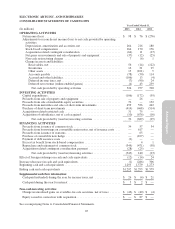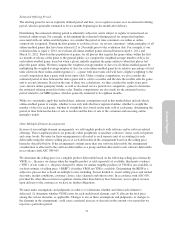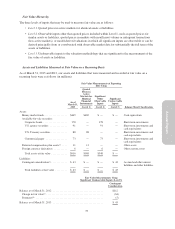Electronic Arts 2013 Annual Report Download - page 152
Download and view the complete annual report
Please find page 152 of the 2013 Electronic Arts annual report below. You can navigate through the pages in the report by either clicking on the pages listed below, or by using the keyword search tool below to find specific information within the annual report.are inherently difficult to assess. At the point of a loss recognition, a new, lower cost basis for that inventory is
established, and subsequent changes in facts and circumstances do not result in the restoration or increase in that
newly established basis.
Property and Equipment, Net
Property and equipment, net, are stated at cost. Depreciation is calculated using the straight-line method over the
following useful lives:
Buildings ..................................... 20to25years
Computer equipment and software ................. 3to6years
Furniture and equipment ......................... 3to5years
Leasehold improvements ......................... Lesser of the lease term or the estimated useful lives
of the improvements, generally 1 to 10 years
We capitalize costs associated with internal-use software that have reached the application development stage
and meet recoverability tests. Such capitalized costs include external direct costs utilized in developing or
obtaining the software, and payroll and payroll-related expenses for employees who are directly associated with
the development of the software. Capitalization of such costs begins when the preliminary project stage is
complete and ceases at the point in which the project is substantially complete and is ready for its intended
purpose. The net book value of capitalized costs associated with internal-use software was $81 million and
$77 million as of March 31, 2013 and 2012, respectively. Once the internal-use software is ready for its intended
use, the assets are depreciated on a straight-line basis over each asset’s estimated useful life, which is generally
three years.
Acquisition-Related Intangibles and Other Long-Lived Assets
We record acquisition-related intangible assets that have finite useful lives, such as developed and core
technology, in connection with business combinations. We amortize the cost of acquisition-related intangible
assets on a straight-line basis over the lesser of their estimated useful lives or the agreement terms, typically from
two to fourteen years. We evaluate acquisition-related intangibles and other long-lived assets for impairment
whenever events or changes in circumstances indicate that the carrying amount of an asset may not be
recoverable. Recoverability of assets is measured by a comparison of the carrying amount of an asset to future
undiscounted net cash flows expected to be generated by the asset. This includes assumptions about future
prospects for the business that the asset relates to and typically involves computations of the estimated future
cash flows to be generated by these businesses. Based on these judgments and assumptions, we determine
whether we need to take an impairment charge to reduce the value of the asset stated on our Consolidated
Balance Sheets to reflect its estimated fair value. Judgments and assumptions about future values and remaining
useful lives are complex and often subjective. They can be affected by a variety of factors, including but not
limited to, significant negative industry or economic trends, significant changes in the manner of our use of the
assets or the strategy of our overall business and significant under-performance relative to projected future
operating results. When we consider such assets to be impaired, the amount of impairment we recognize is
measured by the amount by which the carrying amount of the asset exceeds its fair value. We recognized
$39 million, $12 million, and $14 million in impairment charges in fiscal years 2013, 2012, and 2011,
respectively. The impairment charges for fiscal year 2013 of $34 million and $5 million, are included in cost of
revenue and amortization of intangibles, respectively, on our Consolidated Statement of Operations. The charges
for fiscal year 2012 consist of $12 million included in cost of revenue on our Consolidated Statement of
Operations. The charges for fiscal year 2011 of $14 million are included in restructuring and other charges and
research and development expense in our Consolidated Statements of Operations.
Goodwill
In assessing impairment on our goodwill, we first analyze qualitative factors to determine whether it is more
likely than not that the fair value of a reporting unit is less than its carrying amount as a basis for determining
whether it is necessary to perform the two-step goodwill impairment test. If we conclude it is more likely than
68
























